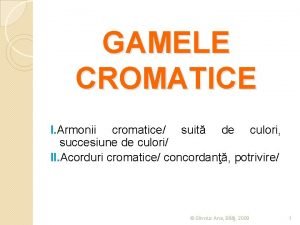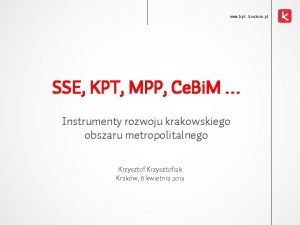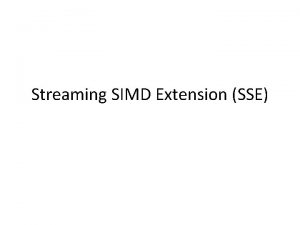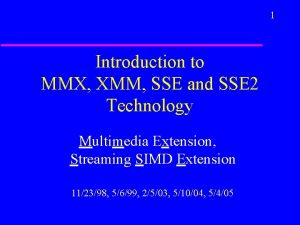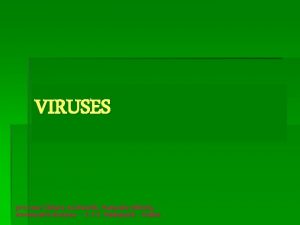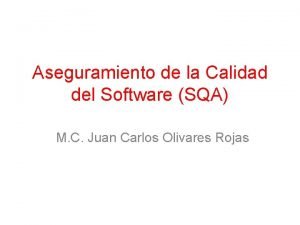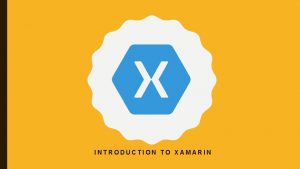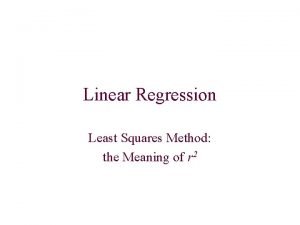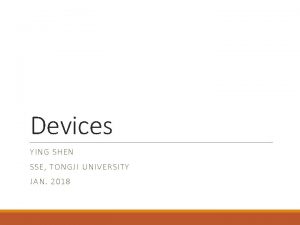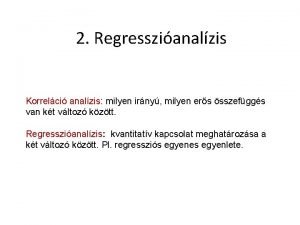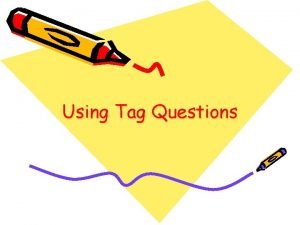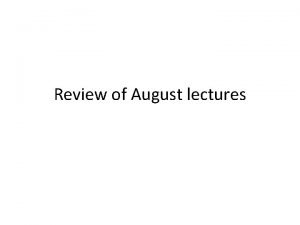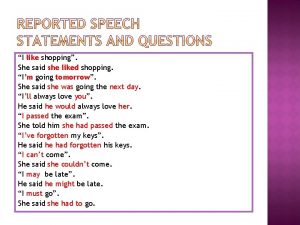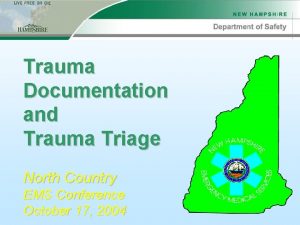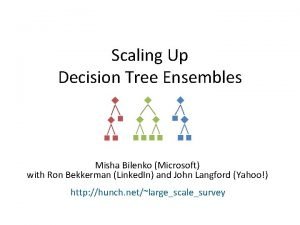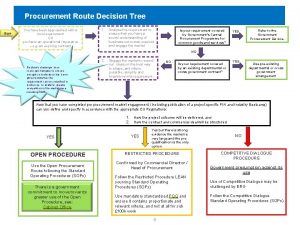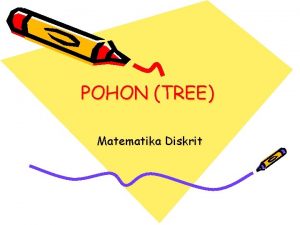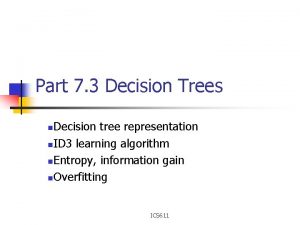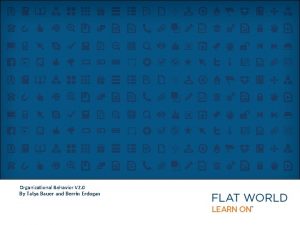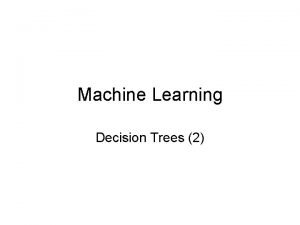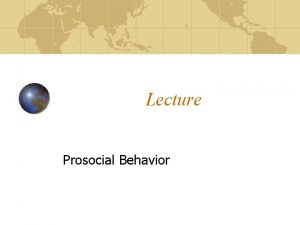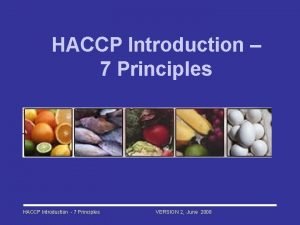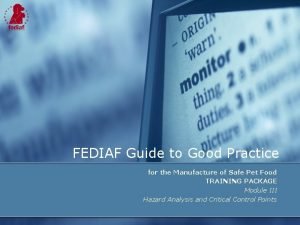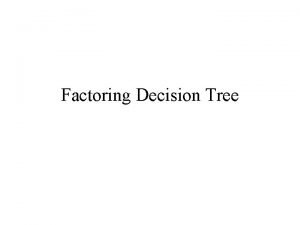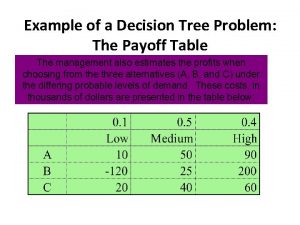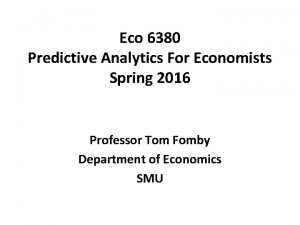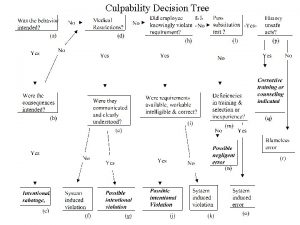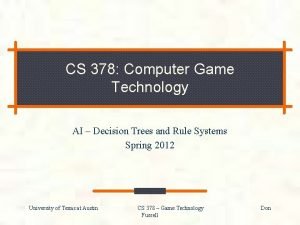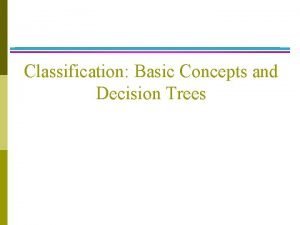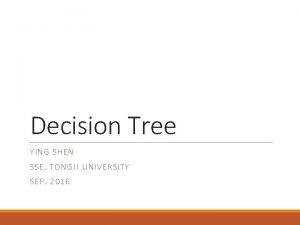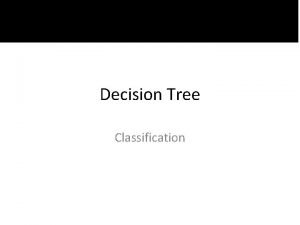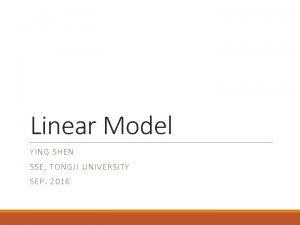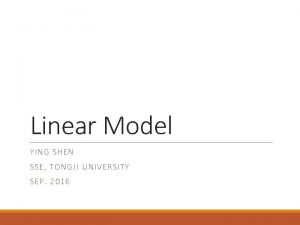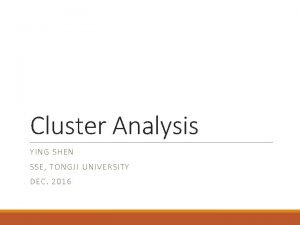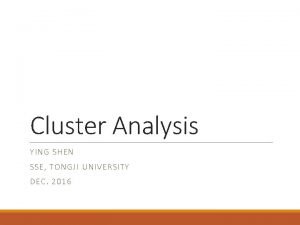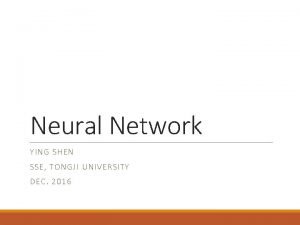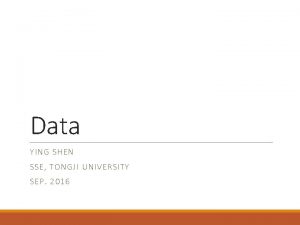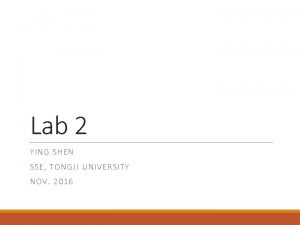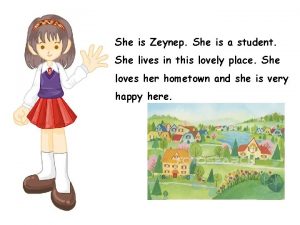Decision Tree YI NG SHE N SSE TON

















































- Slides: 49

Decision Tree YI NG SHE N SSE, TON GJI UNIVERSITY OCT. 2016

Decision tree We can solve a classification problem by asking a series of carefully crafted questions about the attributes of the test record. Each time we receive an answer, a follow-up question is asked. This process is continued until we reach a conclusion about the class label of the record. 12/4/2020 PATTERN RECOGNITION 2

Decision tree The series of questions and answers can be organized in the form of a decision tree. It is a hierarchical structure consisting of nodes and directed edges. The tree has three types of nodes ◦ A root node that has no incoming edges, and zero or more outgoing edges. ◦ Internal nodes, each of which has exactly one incoming edge and two or more outgoing edges. ◦ Leaf or terminal nodes, each of which has exactly one incoming edge and no outgoing edges. 12/4/2020 PATTERN RECOGNITION 3

Decision tree In a decision tree, each leaf node is assigned a class label. The non-terminal nodes, which include the root and other internal nodes, contain attribute test conditions to separate records that have different characteristics. 12/4/2020 PATTERN RECOGNITION 4

Decision tree Classifying a test record is straightforward once a decision tree has been constructed. Starting from the root node, we apply the test condition. We then follow the appropriate branch based on the outcome of the test. This will lead us either to ◦ Another internal node, for which a new test condition is applied, or ◦ A leaf node. The class label associated with the leaf node is then assigned to the record. 12/4/2020 PATTERN RECOGNITION 5

Decision tree construction Efficient algorithms have been developed to induce a reasonably accurate, although suboptimal, decision tree in a reasonable amount of time. These algorithms usually employ a greedy strategy that makes a series of locally optimal decisions about which attribute to use for partitioning the data. 12/4/2020 PATTERN RECOGNITION 6

Decision tree construction A decision tree is grown in a recursive fashion by partitioning the training records into successively purer subsets. We suppose ◦ Un is the set of training records that are associated with node n. ◦ C={c 1, c 2, …, c. K} is the set of class labels. 12/4/2020 PATTERN RECOGNITION 7

Decision tree construction If all the records in Un belong to the same class ck, then n is a leaf node labeled as ck. If Un contains records that belong to more than one class, ◦ An attribute test condition is selected to partition the records into smaller subsets. ◦ A child node is created for each outcome of the test condition. ◦ The records in Un are distributed to the children based on the outcomes. The algorithm is then recursively applied to each child node. 12/4/2020 PATTERN RECOGNITION 8

Decision tree construction For each node, let p(ck) denotes the fraction of training records from class k. In most cases, the leaf node is assigned to the class that has the majority number of training records. The fraction p(ck) for a node can also be used to estimate the probability that a record assigned to that node belongs to class k. 12/4/2020 PATTERN RECOGNITION 9

Decision tree construction Decision trees that are too large are susceptible to a phenomenon known as overfitting. A tree pruning step can be performed to reduce the size of the decision tree. Pruning helps by trimming the tree branches in a way that improves the generalization error. 12/4/2020 PATTERN RECOGNITION 10

Attribute test Each recursive step of the tree-growing process must select an attribute test condition to divide the records into smaller subsets. To implement this step, the algorithm must provide ◦ A method for specifying the test condition for different attribute types and ◦ An objective measure for evaluating the goodness of each test condition. 12/4/2020 PATTERN RECOGNITION 11

Attribute test Binary attributes ◦ The test condition for a binary attribute generates two possible outcomes. 12/4/2020 PATTERN RECOGNITION 12

Attribute test Nominal attributes ◦ A nominal attribute can produce binary or multiway splits. ◦ There are 2 N-1 -1 ways of creating a binary partition of N attribute values. ◦ For a multiway split, the number of outcomes depends on the number of distinct values for the corresponding attribute. 12/4/2020 PATTERN RECOGNITION 13

Attribute test 12/4/2020 PATTERN RECOGNITION 14

Attribute test Ordinal attributes ◦ Ordinal attributes can also produce binary or multiway splits. ◦ Ordinal attributes can be grouped as long as the grouping does not violate the order property of the attribute values. 12/4/2020 PATTERN RECOGNITION 15

Attribute test Continuous attributes ◦ The test condition can be expressed as a comparison test v≤T or v>T with binary outcomes, or ◦ A range query with outcomes of the form Tj≤v< Tj+1, for j=1, …, J For the binary case ◦ The decision tree algorithm must consider all possible split positions T, and ◦ Select the one that produces the best partition. For the multiway split, ◦ The algorithm must consider multiple split positions. 12/4/2020 PATTERN RECOGNITION 16

Attribute test 12/4/2020 PATTERN RECOGNITION 17

Decision tree construction: Example: credit risk estimation An individual’s credit risk depends on such attributes as credit history, current debt, collateral and income. For this example, there exists a decision tree which can correctly classify all the objects. 12/4/2020 PATTERN RECOGNITION 18

Decision tree construction: Example 12/4/2020 PATTERN RECOGNITION 19

Decision tree construction: Example 12/4/2020 PATTERN RECOGNITION 20

Decision tree construction: Example In a decision tree, each internal node represents a test on some attribute, such as credit history or debt. Each possible value of that attribute corresponds to a branch of the tree. Leaf nodes represent classifications, such as low or moderate risk. 12/4/2020 PATTERN RECOGNITION 21

Decision tree construction: Example 12/4/2020 PATTERN RECOGNITION 22

Decision tree construction: Example Suppose income is selected as the root attribute to be tested. This partitions the example set as shown in the figure. 12/4/2020 PATTERN RECOGNITION 23

Decision tree construction: Example Since the partition {1, 4, 7, 11} consists entirely of high-risk individuals, a leaf node is created. 12/4/2020 PATTERN RECOGNITION 24

Decision tree construction: Example For the partition {2, 3, 12, 14} ◦ credit history is selected as the attribute to be tested. ◦ This further divides this partition into {2, 3}, {14} and {12}. 12/4/2020 PATTERN RECOGNITION 25

Information theoretic test Each attribute of an instance contributes a certain amount of information to the classification process. We measure the amount of information gained by the selection of each attribute. We then select the attribute that provides the greatest information gain. 12/4/2020 PATTERN RECOGNITION 26

Information theoretic test Information theory provides a mathematical basis for measuring the information content of a message. We may think of a message as an instance in a collection of possible messages. The information content of a message depends on ◦ The size of this collection ◦ The frequency with which each possible message occurs. 12/4/2020 PATTERN RECOGNITION 27

Information theoretic test 12/4/2020 PATTERN RECOGNITION 28

Information theoretic test We can measure the information content of a set of training instances from the probabilities of occurrences of the different classes. In our example ◦ p(high risk)=6/14 ◦ p(moderate risk)=3/14 ◦ p(low risk)=5/14 12/4/2020 PATTERN RECOGNITION 29

Information theoretic test 12/4/2020 PATTERN RECOGNITION 30

Information theoretic test The information gain provided by making a test at a node is the difference between ◦ The amount of information needed to complete the classification before performing the test. ◦ The amount of information needed to complete the classification after performing the test. The latter is defined as the weighted average of the information in all its subtrees. 12/4/2020 PATTERN RECOGNITION 31

Information theoretic test If we select attribute P, with N values, this will partition U into subsets {U 1, U 2, …, UN}. The average information required to complete the classification after selecting P is 12/4/2020 PATTERN RECOGNITION 32

Information theoretic test 12/4/2020 PATTERN RECOGNITION 33

Information theoretic test 12/4/2020 PATTERN RECOGNITION 34

Information theoretic test 12/4/2020 PATTERN RECOGNITION 35

Information theoretic test Similarly, we can show that ◦ gain(credit history)=0. 266 ◦ gain(debt)=0. 063 ◦ gain(collateral)=0. 207 The attribute income will be selected, since it provides the greatest information gain. 12/4/2020 PATTERN RECOGNITION 36

Continuous attributes If attribute P has continuous numeric values v, we can apply a binary test. The outcome of the test depends on a threshold value T. There are two possible outcomes: ◦ v≤T ◦ v>T The training set is then partitioned into 2 subsets U 1 and U 2. 12/4/2020 PATTERN RECOGNITION 37

Continuous attributes We apply sorting to values of attribute P to result in the sequence {v 1, v 2, …, v. R}. Any threshold between vr and vr+1 will divide the set into two subsets ◦ {v 1, v 2, …, vr} ◦ {vr+1, vr+2, …, v. R} There are R-1 possible splits. 12/4/2020 PATTERN RECOGNITION 38

Continuous attributes 12/4/2020 PATTERN RECOGNITION 39

Impurity measures 12/4/2020 PATTERN RECOGNITION 40

Impurity measures In the following figure, we compare the values of the impurity measures for binary classification problems. p refers to the fraction of records that belong to one of the two classes. All three measures attain their maximum value when p=0. 5. The minimum values of the measures are attained when p equals 0 or 1. 12/4/2020 PATTERN RECOGNITION 41

Impurity measures 12/4/2020 PATTERN RECOGNITION 42

Gain ratio Impurity measures such as entropy and Gini index tend to favor attributes that have a large number of possible values. In many cases, a test condition that results in a large number of outcomes may not be desirable. This is because the number of records associated with each partition is too small to enable us to make any reliable predictions. 12/4/2020 PATTERN RECOGNITION 43

Gain ratio 12/4/2020 PATTERN RECOGNITION 44

Oblique decision tree The test condition described so far involve using only a single attribute at a time. The tree-growing procedure can be viewed as the process of partitioning the attribute space into disjoint regions. The border between two neighboring regions of different classes is known as a decision boundary. 12/4/2020 PATTERN RECOGNITION 45

Oblique decision tree Since the test condition involves only a single attribute, the decision boundaries are rectilinear, i. e. , parallel to the coordinate axes. This limits the expressiveness of the decision tree representation for modeling complex relationships among continuous attributes. 12/4/2020 PATTERN RECOGNITION 46

Oblique decision tree 12/4/2020 PATTERN RECOGNITION 47

Oblique decision tree An oblique decision tree allows test conditions that involve more than one attribute. The following figure illustrates a data set that cannot be classified effectively by a conventional decision tree. This data set can be easily represented by a single node of an oblique decision tree with the test condition x+y<1 However, finding the optimal test condition for a given node can be computationally expensive. 12/4/2020 PATTERN RECOGNITION 48

Oblique decision tree 12/4/2020 PATTERN RECOGNITION 49
 Objectives of decision making
Objectives of decision making Dividend decision in financial management
Dividend decision in financial management Que ton aliment soit ton médicament
Que ton aliment soit ton médicament Gama cromatica desen
Gama cromatica desen 0 856m = cm
0 856m = cm Jelaskan tentang konsep angka indeks
Jelaskan tentang konsep angka indeks Decision tree and decision table examples
Decision tree and decision table examples Mpp kraków
Mpp kraków Simd
Simd Mmx sse
Mmx sse Prof.sse
Prof.sse Sse coverage map
Sse coverage map Sse-cmm
Sse-cmm Introduction to xamarin
Introduction to xamarin Avx sse
Avx sse Ssecmm
Ssecmm Sse linear regression
Sse linear regression Opportunity cost example
Opportunity cost example Sse can never be
Sse can never be Direct control pointing devices
Direct control pointing devices Irny
Irny Today is a beautiful day tag questions
Today is a beautiful day tag questions After i had eaten my lunch
After i had eaten my lunch Who she is or who is she
Who she is or who is she Who was she? where was she? what was happening?
Who was she? where was she? what was happening? Pack she back to she ma
Pack she back to she ma She looks pretty sick. i think she go to a doctor
She looks pretty sick. i think she go to a doctor Finally got a job
Finally got a job She worked hard. she made herself ill
She worked hard. she made herself ill She likes going shopping
She likes going shopping A little adverb
A little adverb Miemss trauma decision tree
Miemss trauma decision tree Decision tree scaling
Decision tree scaling Procurement decision tree
Procurement decision tree Pohon ekspresi matematika diskrit
Pohon ekspresi matematika diskrit Xor decision tree
Xor decision tree Vroom's decision tree approach
Vroom's decision tree approach Decision tree
Decision tree Andrew ng decision tree
Andrew ng decision tree Bystander intervention decision tree
Bystander intervention decision tree What are the 7 principles of haccp system
What are the 7 principles of haccp system Haccp study example
Haccp study example Prime polynomial examples
Prime polynomial examples Decision tree payoff table
Decision tree payoff table Simple decision tree
Simple decision tree Decision tree pdf
Decision tree pdf Culpability decision tree
Culpability decision tree Game ai decision tree
Game ai decision tree Gini
Gini Microsoft decision tree
Microsoft decision tree



